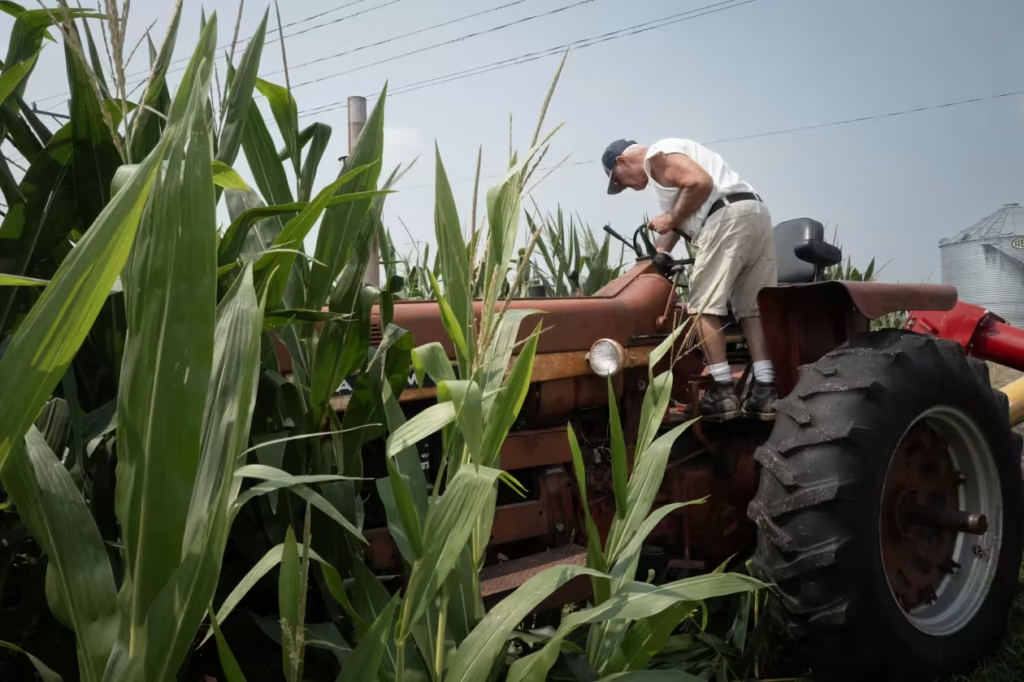Despite the fact that farmers in the Dwight, Illinois, area have been anticipating high yields after a successful growing season, there is worry about lower demand and prices as tariffs run the risk of moving global markets toward less expensive crops in Brazil, which has surpassed the United States as the world’s largest producer of soybeans.
In support of a plan put forth by his agriculture secretary last week, President Donald Trump pledged on Thursday to utilize the money raised from his new import duties to support American farmers.
“We’re going to be taking some money from all of the tariff money that we’ve taken, and we’re going to distribute it to our farmers until the tariffs kick in to their benefit,” Trump said to reporters during an Oval Office meeting with Turkish President Recep Tayyip Erdogan.
It’s a process, but in the end, the farmers will be quite wealthy. “It must take effect,” Trump stated.
He proposed giving farmers a “small percentage” of tariff money later in the day. About $200 billion has been made from tariffs thus far this year.
See also: Trump declares that pharmaceutical companies will be subject to 100% tariffs until they establish factories in the United States.
A week ago, Brooke Rollins, the secretary of agriculture, told the Financial Times that the Trump administration was planning to use tariff income to finance a program that would help American farmers.
However, the bond market doesn’t like the concept of using tariffs for anything other than meeting government spending commitments or paying down U.S. debt, as MarketWatch has reported. Tariff checks for farmers or other Americans might backfire by raising bond yields, which would further increase borrowing costs.
Trump and his supporters have proposed a number of uses for tariff revenue, such as paying for child care or lowering the national debt and doing away with income taxes.
The dismal farm sector was recently emphasized in the Federal Reserve’s “beige book” report. According to the Fed study, contacts in the Kansas City Fed district pointed to high costs and low crop prices as major reasons that are significantly affecting the outlook for agricultural financial situations. All of the major row-crop prices were below farmers’ break-even production costs, according to a St. Louis Fed district contact, making farming an extremely challenging business. Tariffs were driving up fertilizer costs and stoking fears that other nations may target U.S. soybean exports.
Trump has been under fire from Democrats regarding the future of American farmers. According to a statement released by the Democratic National Committee on Tuesday, Trump “promised he’d be the most pro-farmer president ever and that he’d never do anything to hurt farmers, but the numbers and real-life stories tell a completely different tale.”
After the Trump administration pledged aid to the South American country earlier this week, farmers are angry that Argentina is exporting soybeans to China, according to a social media post made Thursday by Republican Sen. Chuck Grassley of Iowa. In order to help farmers who are facing a 20% retaliatory tariff from Beijing on American soybeans, Grassley added that a trade agreement between the United States and China is necessary.
Trump’s administration provided farmers with a bailout during his first term as president, which lasted from 2017 to 2021. The conservative think tank American Enterprise Institute estimated that the assistance totaled more than $23 billion. The AEI claims that this was a reaction to farmers’ perceived losses as a result of Trump’s trade disputes with China and other nations, and it was implemented between 2018 and 2020 through the use of Commodity Credit Corp. spending authority.





